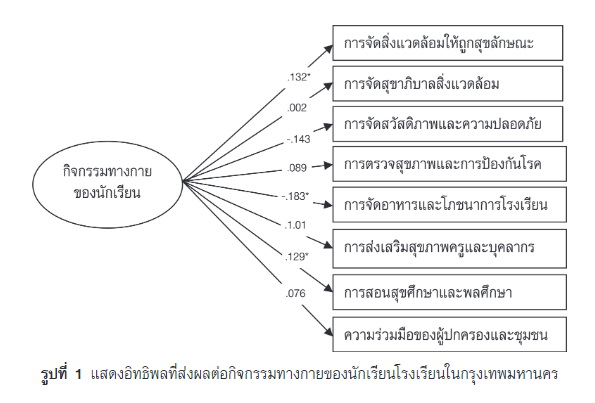STRATEGIES FOR PROMOTING PHYSICAL ACTIVITY OF UPPER ELEMENTARY SCHOOL STUDENTS IN BANGKOK THROUGH ADMINISTRATING SCHOOL HEALTH PROGRAMS
Main Article Content
Abstract
The strategies for promoting physical activity in students by administrating school health programs following the concepts from world health organization is one of the fundamental health factors. It is important that schools should have concrete policies to increase physical activity levels in elementary school since Thai children have less than half the physical activity according to the criteria set by world health organization.
Purpose The purposes of this study were 1) to study the components of administrating school health programs that affect physical activity of students 2) to synthesize strategies for promoting physical activity through administrating school health programs.
Methods The research procedures were 1) simple random sampling, 15 schools in Bangkok, 45 administrators and teachers, and 1,500 students participating in the study. Collect data on conditions and guidelines for administrating school health programs and physical activities of students. Analyze data by examining the influence of factors using structural equation models (SEM) 2) synthesizing strategies for promoting physical activity.
Results The results showed that 1) the influence of variables by using structural equation modeling (SEM) showed consistently with empirical (χ2=24.31, df=13, χ2/df=1.87, P-value p=.06, CFI=.95, RMSEA=.03, SRMR=.04) there are 2 positive influencing factors of school health program management on physical activity, namely healthy environment management and learning–teaching health and physical education, and 1 negative influencing factor which was food and nutrition management. 2) the results of synthesis strategies for promoting physical activity were: organize a space or field for the students to play, teaching health and physical education at least 1 and 2 period / week, arrange for students to have a chance to play after lunch.
Conclusion The results of the study show that there are 3 major components of administrating school health programs including healthy environment management, learning-teaching health and physical education, and food and nutrition management. That effect physical activity of elementary school students.
Article Details
References
Bonde, H. B. (2015). Measuring Physical Activity Health Literacy in Children–Not a Piece of Cake.Research on Health Education. (Online). Retrieved October 13, 2016, European Educational Research Association Website:https://www.eera-ecer.de/ecerprogrammes/conference/20/contribution/34250/.
Centers for Disease Control and Prevention. (2017). School Health Index: A Self-Assessment and Planning Guide (Elementary school version). Atlanta: Georgia. (Mimeographed)
Erawan, P. (2015). Healthy Schools Promotion: An Experience in Thailand. Procedia–Social and Behavioral Sciences, 186, 513-521.
Hillman, C. H., Pontifex, M. B., Raine, L. B., Castelli, D. M., Hall, E. E., and Kramer, A. F. (2009). The effect of acute treadmill walking on cognitive control and academic achievement in preadolescent children. Neuroscience, 159(3), 1044-1054.
Institute for Population and Social Research, Mahidol University. (2017). Thai Health 2017: Empowering Vulnerable Populations Creating an Inclusive Society. Nakhon Pathom: Amarin Printing & Publishing Public Co., Ltd.
Kuna-apisit, W. (2015). The development of Physical Activity Curriculum for Students in Thailand. Bangkok: Physical Activity Research Center.
Lewallen, T. C., Hunt, H., William, P. D., Zaza, S., and Giles, W. (2015). The Whole School, Whole Community, Whole Child Model: A New Approach for Improving Educational Attainment and Healthy Development for Students. journal school health, 85(11), 729-739.
National Statistical Office. (2016). The 2015 physical activity survey. (Online). Retrieved October 13, 2016, National Statistical Office of Thailand Website: https://service.nso.go.th/nso/web/survey/surpop2-4-15.html.
Pavelka, J., Erik, S., Sigmundová, D. (2014). An analysis of conditions for physical activity and physical education in the Czech Republic. Telesná Kultura, 37(1), 9-22.
Sarayuthpitak, J. (2018). School Health Program (3 rd. Ed.). Bangkok: Chulalongkorn University Printing House.
Sarayuthpitak, J., (2014). The Development of a Teaching – Learning Model Based on Affective Domain to Promote in Lower Secondary School Students’ Health. Journal of Education Studies, 42(4), 43-62.
Schaller, A., Dejonghe, L., Goebbels, A. A., Biallas, B. and Froboese, I. (2016). Promoting physical activity and health literacy: study protocol for a longitudinal, mixed methods evaluation of a cross provider workplace-related intervention in Germany (The AtRisk study). BMC Public Health, 16(16), 626.
Soper, D.S. (2016). A-priori Sample Size Calculator for Structural Equation Models. (Online). Retrieved October 13, 2016, Website: https://www.danielsoper.com/statcalc/calculator.aspx?id=89.
Sriramart, S. (2014). Physical activities for wellness. Bangkok: Chulalongkorn University Printing House.
Tangsujjapoj, S. (2012). Organizing physical activities for recreation in educational institutions. (Online). Retrieved October 13, 2016, Website: https://ped.edu.ku.ac.th/home/research/data/29_08_2015_21_16_24.pdf
Thai Health Promotion Foundation. (2016). What is the Physical Activity?. (Online). Retrieved October 13, 2016, Thai Health Promotion Foundation Website: https://www.thaihealth.or.th/Content/32561-%60
Tipwong, A., and Numpoon, J. (2014). The Associations between Health Literacy Related to Obesity and Health Behaviour: Eating and Exercise in over nutritional Children, Bangkok. Journal of Public Health Nursing, 28(2), 1-11.
Udakan, Y., Sangsutthipong, P., Kasiyaphat, A., Thummajunta, K., Sumranbumrung, P., Sritubtim, P., Kosanpipat, P., Treesopanakorn, K., Chaiyamang, A., and Pattanakul, N. (2017). Physical activities for students in border patrol police schools and remote area schools. Journal of Graduate Research, 8(1), 141-154.
Wimonpeerapattana, W., Kijboonchoo, K., Thasanasuwan, W., and Pongurgsorn, C. (2013). Development and Validation of the Physical Activity Questionnaire for Thai Children. KKU Journal, 18(3), 548-557.
World Health Organization (WHO). (2017a). School and youth health. (Online). Retrieved October 13, 2016, World Health Organization Website: https://www.who.int/school youth_health/gshi/hps/en/.
World health organization (WHO). (2017b), Physical activity. (Online). Retrieved October 13, 2016, World Health Organization Website: https://www.who.int/topics/physical_activity/en/.
Zoellner, J. M., Hill, J., You, W., Brock, D., Frisard, M., Alexander, R., Silva, F., Price, B., Marshall, R., and Estabrooks, P. A. (2017). The Influence of Parental Health Literacy Status on Reach, Attendance, Retention, and Outcomes in a Family-Based Childhood Obesity Treatment Program, Virginia, 2013-2015. Preventing Chronic Disease (PCD), 14(87), 1-10.


